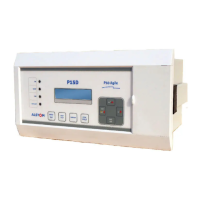2.1.2 Fault Record
A fault record is triggered by any protection signal which trips the circuit breaker. If there are any fault
records, these will appear automatically in the VIEW RECORDS column. You can select the fault
record in the VIEW RECORDS column. A value of '01' corresponds to the latest fault record.
Information about the fault follows in the subsequent cells. The time stamp assigned to the fault record
itself is more accurate than the corresponding stamp of the event record, because the event is logged
after the actual fault record is generated. The fault measurements in the fault record are given at the
time of the protection Start.
After every fault relay latched fault data which can be viewed for detailed analysis. The following are
details of this fault data.
Capacity: 5 faults
Time-tag: 1 millisecond
Triggers: Any selected protection threshold.
Data: Fault number, Type of fault (stage / Phase / EF etc), Trip counter, Fault current magnitude
in Secondary, Trip Timing, Thermal state, Fault date and Fault time.
2.1.3 Disturbance Record
The disturbance recorder can record the waveforms of the calibrated analogue channels, as well as
the values of the digital signals. The disturbance recorder is supplied with data once per cycle, and
collates the received data into a disturbance record. The disturbance records can be extracted using
application software or the SCADA system, which can also store the data in COMTRADE format,
allowing the use of other packages to view the recorded data.
The integral disturbance recorder has an area of memory specifically set aside for storing disturbance
records. The number of records that can be stored is dependent on the recording duration. Up to 5
such waveforms can be recorded; the duration of each disturbance record is 1sec. The maximum total
recording time is 5 seconds.
When the available memory is exhausted, the oldest records are overwritten by the newest ones. The
disturbance recorder stores the samples that are taken at a rate of 12 samples per cycle.
Each disturbance record consists of 4 analogue data channels and 16 digital data channels. The
relevant CT ratio for the analogue channels is also extracted to enable scaling to primary quantities.
The relay records the waveform of the current along with all digital and logical status during a fault.
The disturbance record can be triggered from trip operation of relay. This waveform can be
downloaded via the communication port for further analysis.
The details of the disturbance record are as follows:
Capacity: 5 records of 1 sec each (0.9 sec for pre fault and 0.1 sec for post fault)
Sampling Rage: 12 samples / cycles
Triggers: Trip signal
Data: 4 analogue channels and 16 digital channels (physical and logical status).
2.2 Display of Measuring Parameters
The device directly measures and calculates a number of system quantities, which are updated at
regular intervals. These values can be viewed in the MEASUREMENTS menu on the LCD screen
using the navigation keys on the front panel or using the P50 Agile configurator tool.
In normal conditions the relay displays Primary and Secondary current value of phases A, B, C and
earth current N as per phase/earth CT ratio within ±1% 1% accuracy and Thermal state in %.

